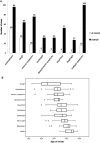Cerebellar ataxia, neuropathy, vestibular areflexia syndrome due to RFC1 repeat expansion
- PMID: 32040566
- PMCID: PMC7009469
- DOI: 10.1093/brain/awz418
Cerebellar ataxia, neuropathy, vestibular areflexia syndrome due to RFC1 repeat expansion
Abstract
Ataxia, causing imbalance, dizziness and falls, is a leading cause of neurological disability. We have recently identified a biallelic intronic AAGGG repeat expansion in replication factor complex subunit 1 (RFC1) as the cause of cerebellar ataxia, neuropathy, vestibular areflexia syndrome (CANVAS) and a major cause of late onset ataxia. Here we describe the full spectrum of the disease phenotype in our first 100 genetically confirmed carriers of biallelic repeat expansions in RFC1 and identify the sensory neuropathy as a common feature in all cases to date. All patients were Caucasian and half were sporadic. Patients typically reported progressive unsteadiness starting in the sixth decade. A dry spasmodic cough was also frequently associated and often preceded by decades the onset of walking difficulty. Sensory symptoms, oscillopsia, dysautonomia and dysarthria were also variably associated. The disease seems to follow a pattern of spatial progression from the early involvement of sensory neurons, to the later appearance of vestibular and cerebellar dysfunction. Half of the patients needed walking aids after 10 years of disease duration and a quarter were wheelchair dependent after 15 years. Overall, two-thirds of cases had full CANVAS. Sensory neuropathy was the only manifestation in 15 patients. Sixteen patients additionally showed cerebellar involvement, and six showed vestibular involvement. The disease is very likely to be underdiagnosed. Repeat expansion in RFC1 should be considered in all cases of sensory ataxic neuropathy, particularly, but not only, if cerebellar dysfunction, vestibular involvement and cough coexist.
Keywords: RFC1; cerebellar ataxia, neuropathy, vestibular areflexia syndrome (CANVAS); chronic cough; repeat expansion; sensory neuropathy.
© The Author(s) (2020). Published by Oxford University Press on behalf of the Guarantors of Brain.
Figures



Comment in
-
CANVAS with cerebellar/sensory/vestibular dysfunction from RFC1 intronic pentanucleotide expansion.Brain. 2020 Feb 1;143(2):386-390. doi: 10.1093/brain/awaa015. Brain. 2020. PMID: 32040556 No abstract available.
-
RFC1 expansions can mimic hereditary sensory neuropathy with cough and Sjögren syndrome.Brain. 2020 Oct 1;143(10):e82. doi: 10.1093/brain/awaa244. Brain. 2020. PMID: 32949124 Free PMC article. No abstract available.
References
-
- Asbury AK. Sensory neuronopathy. Semin Neurol 1987; 7: 58–66. - PubMed
-
- Bronstein AM, Mossman S, Luxon LM. The neck-eye reflex in patients with reduced vestibular and optokinetic function. Brain 1991; 114: 1–11. - PubMed
-
- Burke D, Halmagyi GM. Normal tendon reflexes despite absent sensory nerve action potentials in CANVAS: a neurophysiological study. J Neurol Sci 2018; 387: 75–9. - PubMed
Publication types
MeSH terms
Grants and funding
- 206675/Z/17/Z/WT_/Wellcome Trust/United Kingdom
- G1000848/MRC_/Medical Research Council/United Kingdom
- U54 NS065712/NS/NINDS NIH HHS/United States
- MR/N025431/2/MRC_/Medical Research Council/United Kingdom
- 309548/ERC_/European Research Council/International
- MR/T001712/1/MRC_/Medical Research Council/United Kingdom
- MR/N025431/1/MRC_/Medical Research Council/United Kingdom
- MC_UU_00015/9/MRC_/Medical Research Council/United Kingdom
- 212219/Z/18/Z/WT_/Wellcome Trust/United Kingdom
- 203148/Z/16/Z/WT_/Wellcome Trust/United Kingdom
- MC_UU_00015/7/MRC_/Medical Research Council/United Kingdom
- MR/N010035/1/MRC_/Medical Research Council/United Kingdom
- G0601943/MRC_/Medical Research Council/United Kingdom
- MR/S01165X/1/MRC_/Medical Research Council/United Kingdom
LinkOut - more resources
Full Text Sources
Other Literature Sources
Medical

